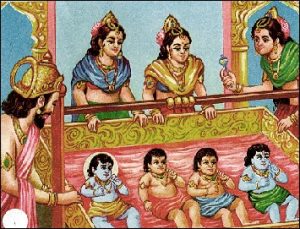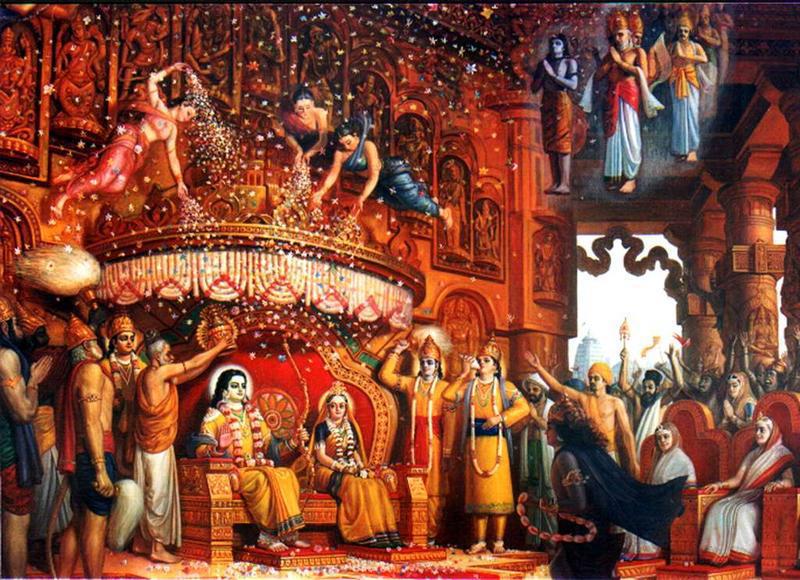From the Valmiki Ramayana, Bala-Kanda.Canto I.
Opening verses:
The celestial Sage Narada narrates to Valmiki the qualities of Sri Ram
The Sage Valmiki once put the following question to Sage Narada, the chief of the hermits and the foremost in the art of expression:
“Is there anyone in this world at present who is full of virtues and at the same time possessed of great prowess, who knows what is right, is well versed in Dharma (religion), who is conscious of service done (grateful), truthful, and of firm resolve?
Who is possessed of right conduct and who is friendly to all living beings. Who is a man of knowledge, who is powerful and who has a singularly lovable appearance. Who has subdued his self, who has conquered anger, who is possessed of splendour and who is above fault-finding and whom the very gods dread when his wrath has been provoked in battle?
I wish to hear this; for there is a great curiosity in my mind about it while you are capable of knowing such a man, O eminent Seer!”
Being pleased on hearing these words of Valmiki, the Sage Narada who possessed knowledge of the three worlds, and greatly delighted, addressed the following words:
“Listen! I shall duly consider and tell you of such a hero. Be pleased to hear from me of the man endowed with the many and rare virtues and qualities mentioned by you.
There is one born in the line of Ikshvaku and known by men by the name of Rama. He has fully controlled his mind, is very powerful, radiant and resolute and has brought his senses under control. He is intelligent, sagacious, eloquent, glorious and an exterminator of foes. He is distinguished with broad shoulders, powerful arms, a neck shaped as a conch and a stout chin.
He is marked with a broad chest, a mighty bow and a collar bone covered with flesh, Ram is capable of subduing his foes. His (unusually long) arms extend right up to his knees. He has a well-formed head, a shapely forehead and a charming gait. He is of medium stature, has well-proportioned limbs and of charming complexion. He is mighty. He has a well-shaped chest, large eyes, is full of splendour and has auspicious marks on his body.
He knows the secret of virtues and is true to his promise. He is intent on the good of the people. He is illustrious, full of wisdom, pure in his dealings, a man of self-control and a sharp (concentrated) mind. He is like the Creator Brahma in supporting all, affluent, the slayer of his enemies, protector of all living beings and a staunch defender of faith (Dharma).
He is well principled and protects his people. He knows the truth expounded in the Vedas and Vedangas (six sciences) auxiliary to them and is a master in archery. He knows the real meaning of all the scriptures, possessed of a bright intellect and good memory. He is gentle, noble, shrewd and is loved by all.
He is always sought by the righteous (even) as the rivers seek the ocean. He is courteous to one and all and always well composed, noble and always wears a pleasing countenance. He is endowed with excellence and gladdens the heart of his mother Kausalya. He is dignified and profound like the ocean and firm (steadfast) like the Himalayas.
He is a replica of Lord Vishnu in prowess and soothing like the moon. In (show of) anger he resembles the conflagration (destructive fire) at dissolution (end of creation). He is a counterpart of Mother Earth in forbearance. He equals Kubera (the god of riches, the bestower of wealth) in liberality and steadfast in truth like Lord Dharma.”



